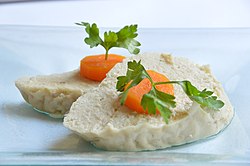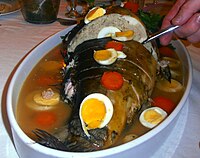Gefilte fish
 Gefilte fish topped with slices of carrot | |
| Course | Hors d'oeuvre |
|---|---|
| Region or state | Central and Eastern Europe, United States, Israel. |
| Created by | Ashkenazi Jewish communities |
| Main ingredients | Ground fish |
Gefilte fish (/ɡəˈfɪltə fɪʃ/; from Yiddish: געפֿילטע פֿיש, lit. "stuffed fish") is a dish made from a poached mixture of ground deboned fish, such as carp, whitefish, or pike. It is traditionally served as an appetizer by Ashkenazi Jewish households. Popular on Shabbat and Jewish holidays such as Passover, it may be consumed throughout the year.
Historically, gefilte fish was a stuffed whole fish consisting of minced-fish forcemeat stuffed inside the intact fish skin. By the 16th century, cooks had started omitting the labor-intensive stuffing step, and the seasoned fish was most commonly formed into patties similar to quenelles or fish balls. [1]
In Poland, gefilte fish, referred to as karp po żydowsku ("carp Jewish-style"), is a traditional dish in most Catholic Polish homes (more commonly in the northern regions near the Baltic Sea), served on Christmas Eve (for twelve-dish supper) and on Holy Saturday.[2]
Preparation and serving[]

Gefilte fish is traditionally cooked inside the intact skin of a fish, forming a loaf which is then sliced into portions before serving. Sometimes it is cooked and served as egg-shaped patties, like quenelles. In the United Kingdom, gefilte fish is commonly fried.[3] Gefilte fish is typically garnished with a slice of carrot on top, and a horseradish mixture called chrain on the side.
To make the modernized "gefilte fish" fish balls, fish fillets are ground and mixed with eggs (some recipes exclude eggs), breadcrumbs or matza crumbs, spices, salt, onions, carrots, and sometimes potatoes, to produce a paste or dough which is then simmered in fish stock.[4]
Carp, pike, mullet, or whitefish were commonly used to make gefilte fish, but recently Nile perch and salmon are also commonly used, with gefilte fish made from salmon having a slightly pink hue.[citation needed] Catfish is not used, however, because Jews consider it non-Kosher.[5]
Variations[]
Gefilte fish may be slightly sweet or savory. Preparation of gefilte fish with sugar or black pepper is considered an indicator of whether a Jewish community was Galitzianer (with sugar) or Litvak (with pepper); the boundary separating northern from southern East Yiddish has thus been dubbed "the Gefilte Fish Line".[6]
Ready-to-serve[]

The post-WWII method of making gefilte fish commercially takes the form of patties or balls, or utilizes a wax paper casing around a "log" of ground fish, which is then poached or baked. This product is sold in cans and glass jars, and packed in jelly made from fish broth. The sodium content is relatively high at 220–290 mg/serving. Low-salt, low-carbohydrate, low-cholesterol, and sugar-free varieties are available. The patent (US 3108882 "Method for Preparing an Edible Fish Product") for this jelly, which allowed mass-market distribution of gefilte fish, was granted on October 29, 1963, to Monroe Nash and Erich G. Freudenstein.[7] Gefilte fish is also sold frozen in "logs".
Religious customs and considerations[]
Among religiously observant Jews, gefilte fish has become a traditional Shabbat food to avoid borer, which is one of the 39 activities prohibited on Shabbat outlined in the Shulchan Aruch. Borer, literally "selection/choosing", would occur when one picks the bones out of the fish, taking "the chaff from within the food".[8]
A less common belief is that fish are not subject to ayin hara ("evil eye") because they are submerged while alive, so that a dish prepared from several fish varieties brings good luck.[9]
Gefilte fish is often eaten on sabbath. However, on sabbath, separating bones from meat, as well as cooking, are forbidden by the Talmud. So usually, the dish is prepared the day before and served cold or at room temperature.
In Polish Catholic homes, gefilte fish (Polish: karp po żydowsku) is a traditional dish to be eaten on Christmas Eve and Holy Saturday, as these are traditionally meatless feasts.[10] This follows a pattern in which a number of Jewish dishes were also eaten on Catholic religious days in Poland.[10]
See also[]
- Fishcake
- Polish cuisine
- Israeli cuisine
- Jewish cuisine
- Kamaboko
- Vorschmack
References[]
- ^ Marks, Gil. Encyclopedia of Jewish Food. Houghton Mifflin.
- ^ Jochnowitz, Eve (1998), "Chapter 4: Flavors of Memory: Jewish Food as Culinary Tourism in Poland", in Long, Lucy M. (ed.), Culinary Tourism, University Press of Kentucky, pp. 97–113, ISBN 0813126398,
In the public imagination of both Americans and Poles, it is frequently gefilte fish—particularly sweetened gefilte fish—that has outdistanced matzoh as the food that first comes to mind when Jewish food is discussed (Cooper 1993; dc Pomianc 1985). Gefilte fish is sometimes referred to as karp po żydowsku or "Jewish carp," ... Many restaurants in Cracow and Warsaw that are in no other way marked as Jewish offer karp po żydowsku as either an appetizer or a main course. Stranger still, karp po żydowsku has become a traditional dish in many Catholic Polish homes for Christmas Eve and Holy Saturday, traditionally meatless feasts.
- ^ "Gefilte Fish, Fried to Perfection". The Forward. Retrieved 2018-07-24.
- ^ Попова, Марта Федоровна (2004). Секреты Одесской кухни. Одесса: Друк. p. 163. ISBN 966-8149-36-X. [Popova, Marta (2004). Secrets of Odessa Cuisine (in Russian). Odessa: Druk. p. 163.]
- ^ "Non-Kosher Gefilte Fish?". 1992. Retrieved 10 September 2021.
- ^ Bill Gladstone: This is no fish tale: Gefilte tastes tell story of ancestry. Jewish Telegraphic Agency, September 10, 1999. Accessed November 10, 2010
- ^ Method of Preparing an Edible Fish Product. Accessed November 10, 2010
- ^ Rabbi Zushe Blech: "The Fortunes of a Fish", Kashrut.com website. Accessed March 30, 2006.
- ^ Gil Marks: "Something's fishy in the State of Israel" Archived 2006-03-29 at the Wayback Machine, Orthodox Union website. Accessed March 30, 2006.
- ^ Jump up to: a b Johnowitz, Eva. Chapter 4, "Flavors of Memory", in Culinary Tourism, Lucy M. Long (ed.). University Press of Kentucky, 2013.
External links[]
- Barbara Kirshenblatt-Gimblett: "Food and Drink". In: The YIVO Encyclopedia of Jews in Eastern Europe, Yale University Press, New Haven 2008, p. 534, ISBN 978-0-300-11903-9.
- Tamara Mann: "Gefilte Fish in America: A history of the Jewish fish product". MyJewishLearning
- Claudia Roden: "Gefilte Fish and the Jews". Jewish Heritage Online Magazine
- Haym Soloveitchik: "Rupture and Reconstruction. The Transformation of Contemporary Orthodoxy" (PDF and HTML). In: Tradition, Vol. 28, No. 4 (Summer 1994).
- Ashkenazi Jewish cuisine
- Carp
- Esox
- Jewish culture
- Jews and Judaism in Europe
- Salmonidae
- Shabbat food
- Yiddish words and phrases
- Stuffed dishes